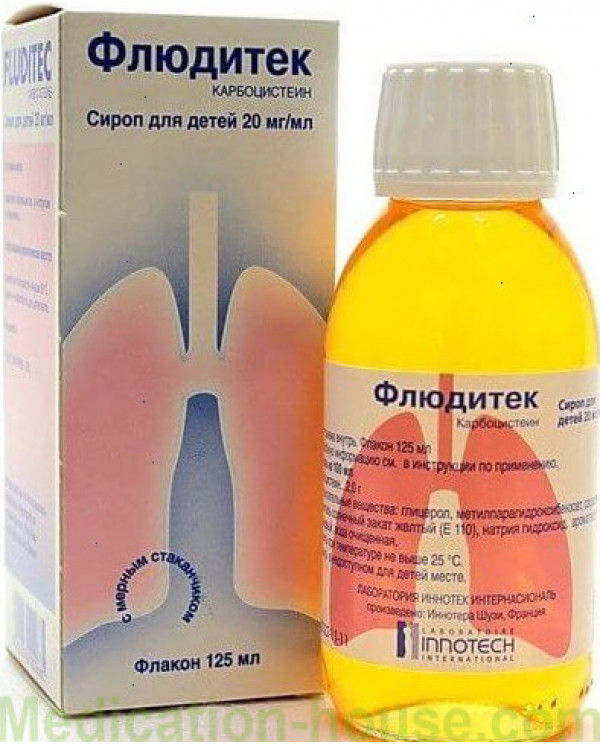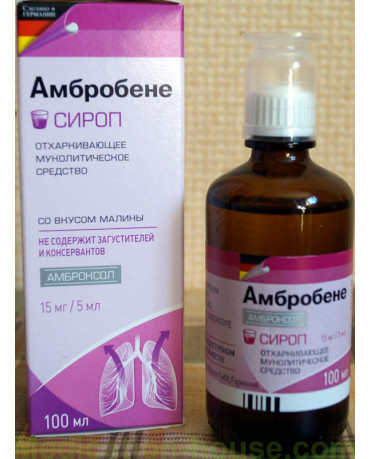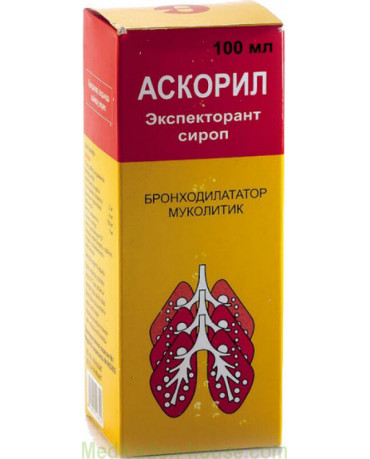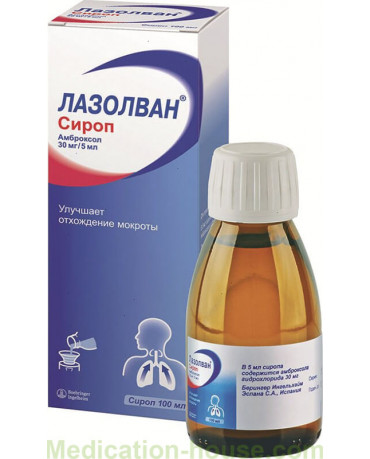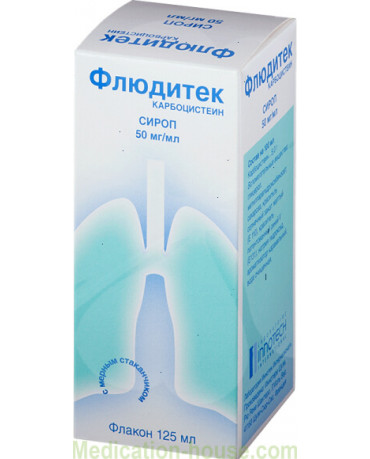Fluditec for children instruction
You can buy Fluditec for children on this page
Release form
The most popular type of Fluditec for children is syrup, which is produced with different concentrations of the active ingredient. It is sold in glass bottles of 125 milliliters, to which a measuring cup is attached. A less concentrated preparation (2%) is an orange clear liquid that smells like a banana. Fluditec for children, which contains more active substance (5%), has a green color and a caramel flavor.
In addition to syrup, the drug is also produced in portioned sachets containing 10 ml of viscous liquid. It is a clear solution that smells of caramel and has a light brown tint. Such sachets are sold in packs of 10, 12 or 15 pieces.
Composition
The main component of the syrup and Fluditec for children solution, which provides the drug with a mucolytic effect, is called carbocysteine. In 1 ml of syrup it is contained in a dose of 20 mg or 50 mg, and one sachet with a solution will immediately give 750 mg of this component.
The auxiliary ingredients of orange and green syrups are the same, with the exception of dyes and flavor. They are represented by glycerol, sodium hydroxide, sucrose, purified water and methyl parahydroxybenzoate. In the Fluditec solution, placed in a sachet, there is sodium saccharin, maltitol, hyetellose, sorbitol and water. This form of medication also includes methyl parahydroxybenzoate, sodium hydroxide and flavorings.
Operating principle
Fluditec for children affects goblet cells that are in the mucous membrane of the bronchi. In particular, the carbocysteine in the composition of the drug affects an enzyme called sialic transferase. Such an enzyme is responsible for the secretion of mucus by goblet cells. The result of this effect is the normalization of the components of the secretion of the bronchi (sialomucins), the restoration of fluidity and viscosity of the mucus, which leads to easier sputum removal.
In addition, the medication stimulates the restoration of the structure of the mucous membrane and positively affects the ciliary epithelium. Carbocysteine also has an effect on local immunity due to the restoration of mucus components, it acts as a non-specific defense, and activates the production of immunoglobulin A (such protection is specific).
After 2–3 hours, the medicine taken inside reaches the maximum concentration in the blood and penetrates the bronchial tissue, remaining in the mucous membrane for up to 8 hours. Withdrawal of the drug occurs in the urine.
Indications
As noted in the instructions to Fluditec for children, the drug is prescribed for diseases of the respiratory tract that occur with changes in the state of sputum.
The drug is most often prescribed for tracheitis and bronchitis. Usually, the medication is in demand in the acute form of such diseases, but it is no less effective in the case of their chronic course. As a result of using Fluditec for children for these pathologies, a dry cough becomes productive and the airways are cleared.
One of the indications for the use of the drug is pneumonia. With such a disease, it is also important to normalize the state of sputum, because this affects the speed of recovery.
The mucolytic effect of the drug is also in demand in asthma. If the patient is diagnosed with this disease, Fluditec for children is prescribed as an additional tool that can thin the viscous mucus.
Annotation to the drug also notes the possibility of its use in ENT practice. Fluditec for children is prescribed for sinusitis, adenoids, laryngitis, runny nose, otitis media and other diseases.
Another reason to appoint Fluditec for children is preparation for the diagnosis of bronchial conditions. The drug is given before bronchoscopy or bronchography, so that thick sputum does not interfere with the procedure.
At what age are they prescribed?
The drug is contraindicated for children under two years of age, and babies who are already 2 years old can be given only 2 percent syrup. This drug is usually called Fluditec for children. A more concentrated syrup, in each milliliter of which contains 50 mg of the active substance, is not prescribed until the age of 15. Fluditec for children in sachets can also be used only in adolescents older than 15 years.
Contraindications
Fluditec for children is not prescribed if the patient:
aggravated peptic ulcer of the digestive tract;
diagnosed with cystitis or exacerbated chronic glomerulonephritis;
there is hypersensitivity to carbocysteine or another ingredient in the drug.
If the child has diabetes, then when prescribing the syrup, one should remember the presence of sucrose in its composition in an amount of 3.5 g in a single dose.
Side effects
Used with a wet cough, Fluditec for children is usually well tolerated, but in some patients this drug may cause:
nausea, flatulence, pain in the stomach and other negative symptoms of gastrointestinal irritation;
weakness, malaise, or dizziness;
urticaria, Quincke's edema, or other allergic reaction.
Instructions for use
The syrup is given to children undiluted, using a teaspoon or tablespoon for dosing. However, it is much more convenient to use a measuring cup, which is sold together with a bottle of medicine. On such a cup there are marks of 5, 10 and 15 ml.
In order for the active component of Fluditec for children to be fully absorbed, the use of such a drug should not be combined with meals. It is best to give your child syrup before meals in about an hour. And it is also possible to take it after the child has eaten, but not earlier than after 2 hours.
The duration of treatment with Fluditec for children should be determined by the doctor, taking into account the course of the disease. Most often, a medication is prescribed in a course lasting 5-10 days.
Dosage
Children 2-15 years old
Small patients of this age, as already noted, are allowed to give only Fluditec for children in a syrup containing carbocysteine at a dose of 20 mg / ml. A single serving of this drug is a teaspoon, that is, 5 ml. If you take this amount of syrup at a time, your child will receive 100 mg of the active ingredient.
The frequency of use and the daily dose in children of different ages is different:
if the child is 2-5 years old, then the medicine is given twice a day, and the maximum daily dosage is called 200 mg;
if the patient is more than 5 years old, then the syrup is taken three times, that is, the daily dose is 300 mg.
Overdose
Too much syrup causes abdominal pain, thinning of the stool, and nausea. When such signs of an overdose appear, symptomatic treatment is recommended.
Interaction with other drugs
Fluditec for children noted the property of enhancing the effect of treatment with antibiotics and glucocorticoids prescribed for respiratory diseases.
When used with atropine-like drugs or antitussive drugs, the activity of the drug will decrease.
Storage conditions
Both the sachet with the solution and the syrup should be kept hidden from the kids. The recommended storage temperature of Fluditec is up to +25 degrees. The shelf life of the medication in syrup is 2 years, in sachets - 18 months.
Reviews
More than 80% of reviews about the use of Fluditec for bronchitis, otitis media, laryngitis and other diseases are positive. In them, the syrup is called effective and praised for its pleasant taste, ease of dispensing and detailed annotation. According to mothers, syrup provokes allergies and other side symptoms very rarely, and relieves cough pretty quickly.
Of the shortcomings of the medication, its high cost is most often mentioned, because of which they often look for a medicine with the same effect, but cheaper.
Some parents complain about the large number of chemical additives in the composition, and sometimes the effect of the drug is not strong enough.
Terms of sell
You can buy Fluditec for children without a prescription.

